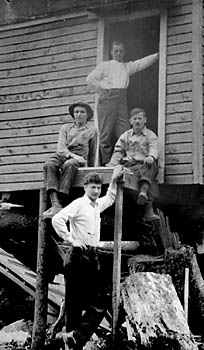
"Where the Rails Turn Up"
Slovenes Come To Richwood
By Nancy Svet Burnett
Young Frank Svet, the author's father seated at left, and Frank Tekavac, standing in front, made a daring escape from Yugoslavia in order to join other Slovenes in Richwood in 1927. They are shown here in a Nicholas County lumber camp along with Tony Grenat seated at right, and woods boss Frank Loncar standing in the doorway. Photographer and date unknown, courtesy of Frances Zadell Tekavac.
In the early 1900's, many Slovenes left their homeland in search of jobs and a better life in America. Now called Slovenia, this mountainous country in south-central Europe was until recently part of Yugoslavia, and, before World War I, was part of Austria. The Bartol, Jonas, Logar, Prelaz, Svet, Urbas, and Wise families of West Virginia were all Slovene immigrants from the village of Cerknica who settled in Richwood, determined to make a new life for themselves in a new land.
Crawling on their stomachs, young Frank Svet and his best friend Frank Tekavec pulled out the tinsnips tucked into their belts and cut the barbed wire separating the Italian and Yugoslav border. They slipped under the wire in the dark of a summer's night and made their way to Trieste to board a ship for America. The year was 1927.
Most emigrants to America did not need to make such a dramatic exit, but these two 17-year-old men were just one year shy of conscription into the Yugoslav army. There were other compelling reasons to emigrate, as well. The economy in the newly formed Yugoslavia was poor, and job prospects were virtually nil. So brothers, sisters, cousins, and employers who were already established in West Virginia recruited fellow Slovenes to work with them in the booming timber town of Richwood. The Slovenes - or Austrians as the locals knew them - were skilled woodsmen. Not only were the woods familiar to them, but their new home in Richwood looked strikingly similar to their hometown of Cerknica.
Travel to the U.S. was by ship with the immigrants packed into steerage-class berths; a normal crossing usually took around two weeks. After long days at sea, the first glimpse of America for the immigrants was the Statue of Liberty in New York harbor, and for many it became the most memorable event of their passage. No immigrant ever forgot seeing this famous symbol.
After enduring the rigors of Ellis Island, the Slovenes moved on to the next stage of their journey - the train station in Manhattan where they would board a train for Richwood. Wishing to reassure themselves about the upcoming train trip, the immigrants would frustratedly try to communicate in a strange language. Cecilia Tekavec Logar was able to finally ask the conductor, "What time clock train go?" The conductor pointed on his watch to the correct departure time.
Frank Svet was concerned about where he would get off the train. When he asked, the conductor gestured by lifting his hands up toward his shoulders, indicating steel rails bending back over themselves. "Son, just ride 'til you don't see any more tracks. Where the rails turn up will be Richwood - the end of the line.
You can read the rest of this article in the Winter 2000 issue of Goldenseal, available in bookstores, libraries or direct from Goldenseal.